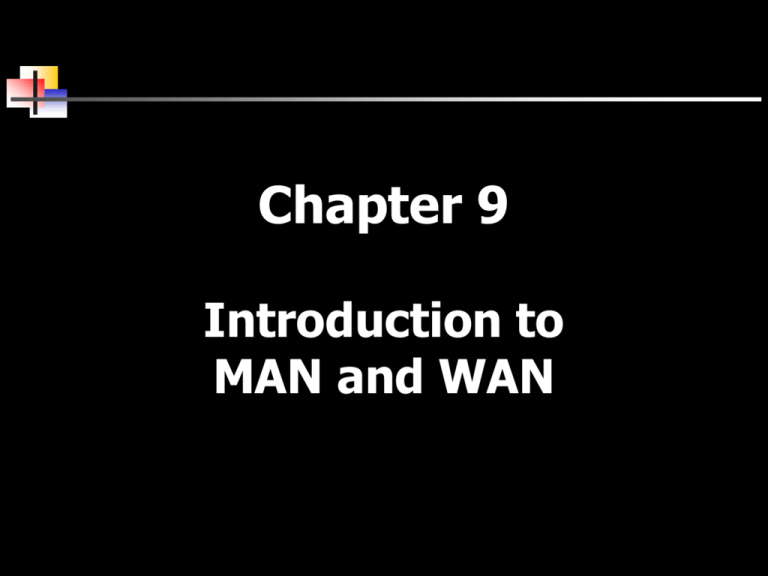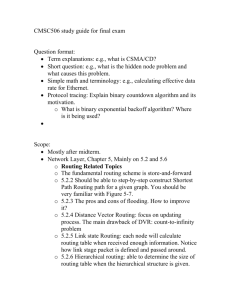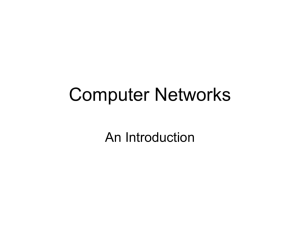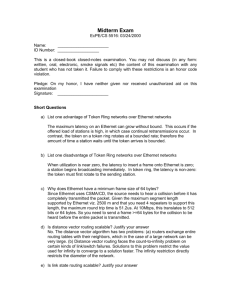Chapter 10 Introduction to MAN and WAN
advertisement

Chapter 9 Introduction to MAN and WAN MAN Basics Borrow technologies from LANs and WANs. Support: high-speed disaster recovery systems, real-time transaction backup systems, interconnections between corporate data centers and Internet service providers, and government, business, medicine, and education high-speed interconnections Almost exclusively fiber optic systems. Very high transfer speeds. Recover from network faults very quickly (failover time). Often a ring topology. Some MANs can be provisioned dynamically. 2 3 SONET vs. Ethernet Most MANs are SONET network built of multiple rings (for failover purposes) SONET: Well-proven but complex, fairly expensive, and cannot be provisioned dynamically Based upon T-1 rates and does not fit nicely into 1 Mbps, 10 Mbps, 100 Mbps, 1000 Mbps chunks, like Ethernet systems do Ethernet MANs generally have high failover times 4 SONET MAN Ethernet MAN 5 Metro Ethernet Metro Ethernet is a service in which the provider creates a door-to-door Ethernet connection between two locations connect one business with a second business using a pointto-point Ethernet connection. connect one business with multiple businesses using a connection similar to a large local area network. by sending out one packet, multiple companies may receive the data. seamlessly connects with a company’s internal Ethernet network(s). 6 Point-to-point MultiPoint-to-multipoint 7 WAN Basics WANs used to be characterized with slow, noisy lines Today WANs are very high speed with very low error rates WANs often follow a mesh topology Station – device that interfaces a user to a network Node – device that allows one or more stations to access the physical network and is a transfer point for passing information through a network A node is often a computer, router, or telephone switch Sub-network (or physical network) – underlying connection of nodes and telecommunication links 8 9 Types of Network Structures Circuit-switched network – Network in which a dedicated circuit is established between sender and receiver All data passes over this circuit Telephone system is a common example Connection is dedicated until one party or another terminates the connection AT&T announced end of 2009 that they will begin phasing out their switched networks Packet-switched network – Network in which all data messages are transmitted using fixed-sized packages, called packets More efficient use of a telecommunications line since packets from multiple sources can share the medium. One form of packet switched network is the datagram With a datagram, each packet is on its own and may follow its own path Virtual circuit creates a logical path through the subnet All packets from one connection follow this path Broadcast network – old LAN technology used in WAN. A workstation transmits its data and all other workstations “connected” to the network hear the data. Only the workstation(s) with the proper address will accept the data. 10 11 Connection-oriented vs. Connectionless A network application can be either connection-oriented or connectionless. Connection-oriented requires both sender and receiver to create a connection before any data is transferred. Applications such as large file transfers and sensitive transactions such as banking and business are typically connection-oriented. can operate over both a circuit-switched network or a packetswitched network. Connectionless does not create a connection first but simply sends the data. Electronic mail is a common example. can operate over both a circuit-switched network or a packetswitched network but a packet-switched network may be more efficient. 12 Routing Each node in a WAN is a router that: 1. 2. 3. Accepts an input packet Examines the destination address Forwards the packet on to a particular telecommunications line How does a router decide which line to transmit on? Router must select one transmission line that will best provide a path to the destination in an optimal manner Often many possible routes exist between sender and receiver The communications network with its nodes and telecommunication links is essentially a weighted network graph The edges, or telecommunication links, between nodes, have a cost associated with them Could be a delay cost, queue size cost, limiting speed, or simply a dollar amount for using that link 13 14 Routing Decision The routing method, or algorithm should be: Optimal, so the least cost can be found Fair, so all packets are treated equally Robust, in case link or node failures occur and the network has to reroute traffic Not too robust so that the chosen paths do not oscillate too quickly between troubled spots Dijkstra’s least cost algorithm finds all possible paths between two locations. By identifying all possible paths, it also identifies the least cost path. The algorithm can be applied to determine the least cost path between any pair of nodes. 15 16 Flooding Routing When a packet arrives at a node, the node sends a copy of the packet out to every link except the link the packet arrived on Traffic grows very quickly when every node floods the packet To limit uncontrolled growth, each packet has a hop count Every time a packet hops, its hop count is incremented When a packet’s hop count equals a global hop limit, the packet is discarded 17 Centralized Routing One routing table is kept at a “central” node Whenever a node needs a routing decision, the central node is consulted To survive central node failure, the routing table should be kept at a backup location The central node should be designed to support a high amount of traffic consisting of routing requests 18 Distributed Routing Each node maintains its own routing table No central site holds a global table Somehow each node has to share information with other nodes so that the individual routing tables can be created Possible problem: individual routing tables holding inaccurate information 19 Adaptive vs. Static Routing Adaptive Routing tables can change to reflect changes in the network Static Does not allow the routing tables to change. Is simpler but does not adapt to network congestion or failures 20 Routing Examples Routing Information Protocol (RIP): First routing protocol used on the Internet Form of distance vector routing Adaptive and distributed Each node kept its own table and exchanged routing information with its neighbors Open Shortest Path First (OSPF): Second routing protocol used on the Internet A form of link state routing Adaptive and distributed More complicated and performed much better than RIP 21 Network Congestion When a network or a part of a network becomes so saturated with data packets that packet transfer is noticeably impeded, network congestion occurs What can cause network congestion? Node and link failures High amounts of traffic Improper network planning When serious congestion occurs, buffers overflow and packets are lost What can we do to reduce or eliminate network congestion? An application can observe its own traffic and notice if packets are disappearing If so, there may be congestion This is called implicit congestion control The network can inform its applications that congestion has occurred and the applications can take action This is called explicit congestion control 22 Congestion Avoidance Before making a connection, user requests how much bandwidth is needed, or if connection needs to be real-time Network checks to see if it can satisfy user request If user request can be satisfied, connection is established If a user does not need a high bandwidth or real-time, a simpler, cheaper connection is created Asynchronous transfer mode is a very good example of this This is often called connection admission control 23









